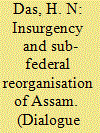| Srl | Item |
| 1 |
ID:
135439


|
|
|
|
|
| Summary/Abstract |
The Indian polity is federal in structure but unitary in bias. A strong Central government is its hallmark. That is why the architect of the Indian Constitution, Dr. B. R. Ambedkar, described India’s polity as a
‘flexible federation.’ Federalism in India has a native flavour also. We can trace it back to the Kingdom of Vaishali of the sixth century B.C. Later the Mauryas, the Guptas, the Mughals and the British used this
concept while organizing the administrative systems of their respective empires with strong Central governments. It was in the above background that the Indian Constitution of 1950 had been drafted. Its unitary features are manifest in several provisions and specially in article 356 which has given the Government of India (GoI) certain unique controlling powers such that in special circumstances it can even take over the administration of a particular State. This provision is not available in any other federal country. Then there are certain institutions common to GoI and all States. These include the Election Commission, the Union Public Service Commission, the Comptroller and Auditor General of India, the Finance Commissions, the higher Judiciary, the All India Civil Services and the central para-military forces. Other common institutions include the Planning Commission, the National Development
Council, the National Integration Council and the Inter-State Council.
|
|
|
|
|
|
|
|
|
|
|
|
|
|
|
|
| 2 |
ID:
129404


|
|
|
|
|
| Publication |
2014.
|
| Summary/Abstract |
From the beginning of human existence people have moved in groups in search of food and also for ensuring security. Groups have expanded into ethnic communities with separate identities, then into races and ultimately into nations. People have come to distinguish themselves by the colour of their skins; the different languages they speak, faith, religion or regions they inhabited. As civilization advanced, people
became more attached to one community or another. Particular territories were carved out as the habitat of particular communities or races. Even within universal empires sub-divisions became discernible. Sometimes racial conflicts arose. The imperial powers had to intervene and mediate in such disputes
|
|
|
|
|
|
|
|
|
|
|
|
|
|
|
|